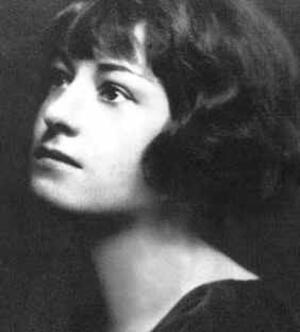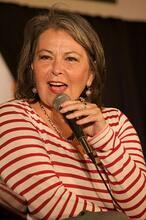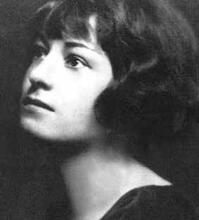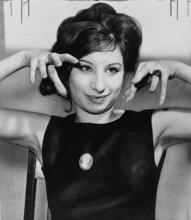Dorothy Rothschild Parker
Courtesy of Wikimedia.
At 25, Dorothy Parker became Vanity Fair’s drama critic, an unprecedented position for a woman. She was an immediate success, known for being vicious and funny, but lost her job in 1920, when her reviews offended the theater elite. Parker was part of a small group of writers whose frequent gatherings became the famous “Algonquin Round Table.” Her first volume of collected poetry, Enough Rope (1926), was an instant best-seller, and her most acclaimed story, “Big Blond,” won the O. Henry Prize in 1929. Like many of Parker’s stories, it highlights the lack of possibilities faced by many women. Parker and her second husband became a Hollywood screenwriting team whose credits included the original A Star Is Born (1939). Parker was also committed to activism, being blacklisted in the 1950s for her pro-Left views.
Early Life
Brilliant, unrelenting, and fiercely witty, Dorothy Rothschild Parker came to signify the urbane and irreverent sensibility of New York City in the 1920s. As an adult, Parker rarely spoke of her family and Upper West Side upbringing, although she often hinted that her past had been tragic. The youngest of three siblings by many years, Dorothy was born on August 22, 1893, to a Jewish father, J. Henry Rothschild, and a Scottish mother, Eliza (Marston) Rothschild. Eliza Rothschild died when Parker was five years old, an event that devastated the child. Soon thereafter, her father, who had made a small fortune in the garment industry, married a strict Roman Catholic, whom Dorothy bitterly disliked.
As a young girl, she attended, and despised, a Catholic school in Manhattan, later transferring to Miss Dana’s, a boarding school. Henry Rothschild told the school authorities that his daughter was Episcopalian, but her dark Jewishness marked her as an outsider. She would always maintain this image of herself, and in the face of early alienation and many disappointments, she developed a biting and irreverent sense of humor. Late in life, she described herself as “one of those awful children who wrote verses,” but despite her writerly inclinations, she left school abruptly at age fourteen, never to return, to take care of her ill father, who was once again a widower. When he died in 1913, the twenty-year-old Dorothy made a living by playing piano at a Manhattan dance school.
Early Writing Career
In 1917, she married Edwin Pond Parker II; it was a marriage doomed to years of alcohol-soaked pain and eventual dissolution. A stockbroker from a prestigious Hartford, Connecticut, family, the handsome Edwin Parker shared Dorothy’s love of excitement and had the advantage of what she later termed “a nice, clean name.” Shortly after their wedding, Edwin went off to war, leaving Dorothy alone in New York. That same year, she became a staff writer at Vanity Fair magazine, and quickly distinguished herself there with her cutting and well-turned humor. In 1918, at age twenty-five and with little tolerance for the popular theater (although she would later write four plays herself), she succeeded P.G. Wodehouse as Vanity Fair’s drama critic. It was an unprecedented position for a woman of any age at that time. Parker was an immediate success: notoriously vicious, and notoriously funny. “If you don’t knit, bring a book,” she moaned in one review. When she lost her job in 1920, after her famously tart reviews offended the sensibilities of the theater elite, Robert Benchley, her close friend and fellow Vanity Fair writer, resigned in protest. It was, Parker said, “the greatest act of friendship I’d known.”
Parker, Benchley, and Robert Sherwood (also of Vanity Fair) lunched regularly at the Algonquin Hotel with a small group of self-publicizing writers eager to create a legend out of their own banter, bons mots, insults, and decrees. In addition to the Vanity Fair trio, the “Algonquin Round Table” included newspapermen Alexander Woollcott and Harold Ross (who would found the New Yorker magazine in 1925) and, in subsequent years, Edna Ferber, Harpo Marx, Tallulah Bankhead, and other notable figures in literary and theatrical circles. The Round Table was the perfect forum for Parker’s incomparably quick tongue, and soon her quietly dropped words became those most listened for. Asked during this period to use the word “horticulture” in a sentence, she famously responded, “You can lead a horticulture, but you can’t make her think.” She rarely failed to surprise and delight her eager audience, and her droll asides were circulated throughout sophisticated New York circles.
But despite her growing fame and the endless parties where she always took center stage, Parker was miserable. Lurking behind her quest for fun was a growing sense of desperation, as her short poem “The Flaw in Paganism” indicates:
Drink and dance and laugh and lie,
Love, the reeling midnight through,
For tomorrow we shall die!
(But, alas, we never do.)
Her insistent hopefulness always seemed to be sideswiped by catastrophe or disappointment—as she put it, “laughter, hope and a sock in the eye.” She was deeply dissatisfied with the free-lance magazine writing she did in the 1920s, had serious money problems, and was involved in a succession of painfully brief love affairs with men who cared little for her. All these troubles led to two failed suicide attempts, in 1923 (following an abortion) and 1925. Her marriage to the morphine- and alcohol-addicted Edwin Parker finally ended in 1928. Through her worst years, Parker maintained a tough-talking and hard-drinking public exterior, scoffing at her own misery with blasé humor.
Poetry and Other Publications
At the suggestion of a friend, Parker collected a volume of her poetry in 1926 to pay for an overseas trip, although she herself felt her verse was not good enough for a book. To her great surprise, Enough Rope became an instant best-seller, rare for a book of poems. In this and subsequent successful volumes of poetry—Sunset Gun (1928), Death and Taxes (1931), and Not So Deep as a Well (1936)—Parker poked fun at her own heartbreak, masochism, and hopefulness. Her most effective verse captures the breadth of her dreams and disappointments with bitter irony and perfect turns of phrase, but only hints at their depths.
Parker’s stories, like her poetry, resonate with heartache and disenchantment, and reflect her obsessions: incessant alcohol consumption, spoiled romance, social injustice, and the follies of the rich. Her most acclaimed story, “Big Blond,” won the O. Henry Prize in 1929. It depicts the drunken loneliness, male dependence, and increasing desperation of an aging “kept woman.” Like many of Parker’s stories, it highlights, with intense and desolate intimacy, the lack of possibilities faced by many women. Other stories were collected in Laments for the Living (1930), After Such Pleasures (1933), and Here Lies (1939). Parker also produced a great deal of literary criticism, published over many decades in the New Yorker (under the title “Constant Reader”) and, from 1958 to 1963, in Esquire. These reviews were often penned with the same unblinking brutality as her earlier drama reviews (of A.A. Milne’s The House at Pooh Corner, she said, “Tonstant Weader Fwowed Up”), although as often they were generously sensitive and enthusiastic.
Activism and Screenwriting
Despite her cynicism, Parker was deeply earnest about politics and maintained a lifelong, if intermittent, commitment to activism. She surprised her New York friends in the 1920s when she was arrested while marching for the release of the anarchists Sacco and Vanzetti. In later years, she went to Spain to work against Franco in the Spanish Civil War (“the proudest thing” she ever did), organized Hollywood screenwriters, and was blacklisted in the 1950s for her pro-Left views. While she still spent many weekends at the homes of rich friends, the pleasures she took in wealth were always mingled with fierce disdain.
In 1934, at age forty, Parker married the writer Alan Campbell, who was eleven years her junior. The couple became a Hollywood screenwriting team whose credits included the original A Star Is Born (1939). Although she found it hard to refuse the huge paychecks, Parker was not proud of her work in Hollywood and felt (as she did about reviewing) that screenwriting kept her from serious literary engagement. She was able to produce stories and poems only sporadically in the 1930s and later years, and never reached the level of productivity to which she aspired nor wrote the novel she had always dreamed of writing. Campbell, who was also half-Jewish, adored her, but was often eclipsed by her powerful talent and personality. Their relationship was complicated by economic woes, as well as their ongoing alcoholism and his homosexuality. The couple divorced in 1947, remarried in 1950, separated in 1953, and reconciled again in 1956, staying together until Campbell’s death in 1963.
Before her lonely death in New York on June 7, 1967, Parker disparaged the life that she and other Round Tablers had led. She also judged her own writing harshly as derivative and not living up to her promise. “I was following in the exquisite footsteps of Miss Edna St. Vincent Millay,” she once claimed, “unhappily in my own horrible sneakers.” Elsewhere she said that she had been “just a little Jewish girl trying to be cute.” However, her work uniquely catalogued society’s random pretensions and her own tough, intimate longings. She remains one of the most shrewdly sensitive and elegant satirists of the twentieth century.
SELECTED WORKS BY DOROTHY PARKER
After Such Pleasures (1933).
Death and Taxes (1931).
Enough Rope (1926).
Here Lies (1939).
Laments for the Living (1930).
Not So Deep as a Well (1936).
The Portable Dorothy Parker (1976).
Sunset Gun (1928).
A Star Is Born, with Alan Campbell (screenplay) (1939).
BEOAJ.
Cooper, Wyatt. “Remembering Dorothy Parker.” Esquire (July 1968).
DAB 8.
EJ.
Gaines, James R. Wits End: Days and Nights of the Algonquin Round Table (1977).
Harriman, Margaret Case. The Vicious Circle: The Story of the Algonquin Round Table (1951).
Hellman, Lillian. An Unfinished Woman: A Memoir (1969).
Keats, John. You Might as Well Live: The Life and Times of Dorothy Parker (1970).
Meade, Marion. Dorothy Parker: What Fresh Hell Is This? (1989).
NAW modern.
Obituary. NYTimes, June 8, 1967, 1:2.
Parker, Dorothy. Interview, June 1959. Oral History Collection, Columbia University, NYC, and Interview. In Writers at Work: The Paris Review Interviews, edited by Malcolm Cowley (1958).
UJE.
Woollcott, Alexander. “Our Mrs. Parker.” In The Portable Woollcott (1946).
WWWIA 4.








